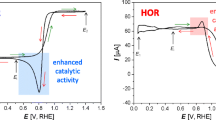Abstract
This study investigated the addition of vanadium phosphate [VO(H2PO4)2] to platinum/carbon (Pt/C) to prepare Pt/C–VO(H2PO4)2 catalyst. Pt/C electrocatalyst was treated with vanadium pentoxide (V2O5) and phosphoric acid concentration to produce VO(H2PO4)2. This combination improved the durability of proton exchange membrane fuel cells (PEMFCs); nonetheless, the addition of VO(H2PO4)2 did not negatively affect the homogenization and electrochemical activity of the Pt/C catalyst. Moreover, the presence of VO(H2PO4)2 was confirmed by the X-ray diffraction pattern and the energy spectrum. The ideal VO(H2PO4)2 ratio (6 %) was determined, and the VO(H2PO4)2 was imported to reduce oxidation in the weak acid environment of the PEMFCs cathode catalyst. When the fuel cell operates at high potential, VO2+ is oxidized to VO2 +. This preferential oxidation protects carbon carriers against oxidation. When the fuel cell returns to normal working potential, the VO2 + is restored to VO2+. VO2+ is a reserve for the protection of carbon carriers at the subsequent instance of high potential. The oxide between the Pt particles coated the surface of the carbon carriers, thus limiting the aggregation and loss of Pt. These two functions enhance the durability of fuel cell electrodes.
Graphical Abstract










Similar content being viewed by others
References
Sato Y, Wang Z, Takagi Y (2006) Effect of anode catalyst support on MEA degradation caused by hydrogen-starved operation of a PEFC. ECS Trans 3:827–833
Dingreville R, Qu J, Cherkaoui M (2005) Surface free energy and its effect on the elastic behavior of nano-sized particles, wires and films. J Mech Phys Solids 53:1827–1854
Chung CG, Kim L, Sung YW, Lee J, Chung JS (2009) Degradation mechanism of electrocatalyst during long-term operation of PEMFC. Int J Hydrogen Energy 34:8974–8981
Ferreira PJ, laO’ GJ, Shao-Horn Y (2005) Instability of Pt/C electrocatalysts in proton exchange membrane fuel cells. J Electrochem Soc 152:A2256–A2271
Zhang J, Sasaki K, Sutter E, Adzic RR (2007) Stabilization of platinum oxygen-reduction electrocatalysts using gold clusters. Science 315:220–222
Mayrhofer KJJ, Meier JC, Ashton SJ et al (2008) Fuel cell catalyst degradation on the nanoscale. Electrochem Commun 10:1144–1147
Luo Z, Li D, Tang H, Pan M, Ruan R (2006) Degradation behavior of membrane-electrode-assembly materials I 10-cell PEMFC stack. Int J Hydrogen Energy 31:1831–1837
Mitsushima S, Sawahara S, Ota K, Kamiya NJ (2007) Consumption rate of Pt under potential cycling. Electrochem Soc 154:B153–158
Wang X, Kumar R, Myers DJ (2006) Effect of voltage on platinum dissolution relevance to polymer electrolyte fuel cells. Electrochem Solid State Lett 9:A225–A227
Cheng X, Shi Z, Glass N (2007) A review of PEM hydrogen fuel cell contamination: impacts, mechanisms, and mitigation. J Power Sources 165:739–756
Garzon FH, Rockward T, Urdampilleta IG, Brosha EL, Uribe FA (2006) The impact of hydrogen fuel contaminations on long-term PEMFC performance. ECS Trans 3:695–703
Franck-Lacaze L, Bonnet C, Besse S, Lapicque F (2009) Effects of ozone on the performance of a polymer electrolyte membrane fuel cell. Fuel Cells 9:562–569
Mukerjee S, Srinivasan S (1993) Enhanced electrocatalysis of oxygen reduction reaction on platinum alloys in proton-exchange membrane fuel cells. J Electroanal Chem 357:201–224
Franco AA, Passot S, Fugier P et al (2009) PtxCoy catalyst degradation in PEFC environments: mechanistic insights I. Multiscale modeling. J Electrochem Soc 156:B410–B424
Antolini E, Salgado JRC, Gonzalez ER (2006) The stability of Pt–M alloy catalysts and its effect on the activity in low temperature fuel cells, a literature review and text on a Pt-Co catalyst. J Power Source 160:957–968
Nørskov JK, Bligaard T, Hvolbæk B, Abild-Pedersen F, Chorkendorff I, Christensen CH (2008) The nature of the active site in heterogeneous metal catalysis. Chem Soc Rev 37:2163–2171
Liu Z, Tian ZQ, Jiang SP (2006) Synthesis and characterization of Nafion-stabilized Pt nanoparticles for polymer electrolyte fuel. Electrochim Acta 52:1213–1220
Acknowledgments
This research was funded by the National Basic Research Program of China (973 Program, Grant No. 2012CB215500) and the National Natural Science Foundation of China (No. 21406024).
Author information
Authors and Affiliations
Corresponding author
Rights and permissions
About this article
Cite this article
Li, Y., Xu, H., Zhao, H. et al. Improving the durability of Pt/C catalyst in PEM fuel cell by doping vanadium phosphate oxygen. J Appl Electrochem 46, 183–189 (2016). https://doi.org/10.1007/s10800-015-0902-4
Received:
Accepted:
Published:
Issue Date:
DOI: https://doi.org/10.1007/s10800-015-0902-4




